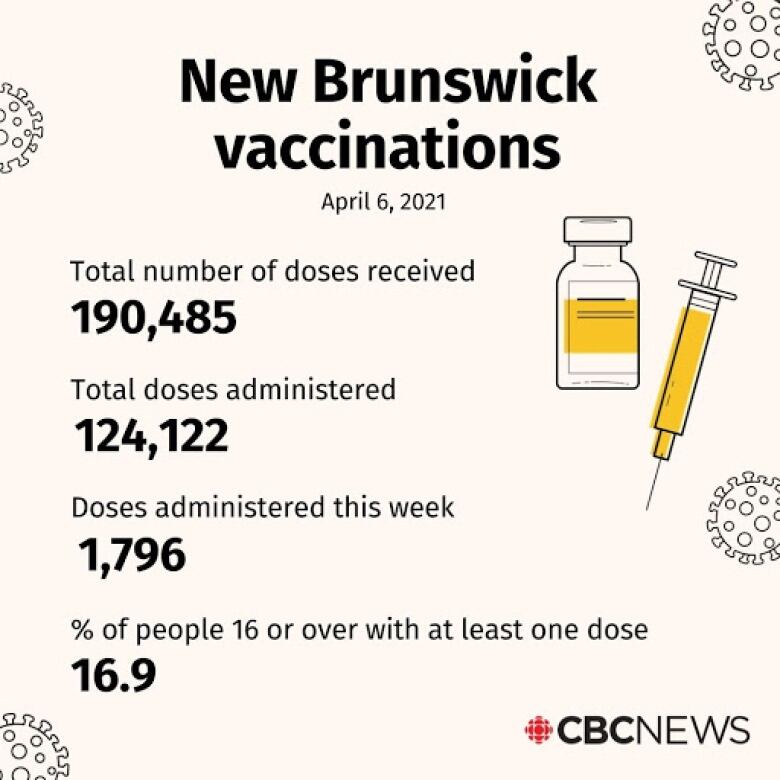N.B. COVID-19 roundup: Patients as young as 25 now in intensive care, Public Health says
Edmundston hospital ICU at capacity, so patients to be diverted

Latest
- Edmundston hospital ICU 'at capacity,' patients to be diverted
- 18 people in N.B. hospitals include 12 in ICU
- 3 new cases in 3 different zones
- 7 cases reported in the Moncton region, Zone 1, are connected and travel-related
- Online vaccination booking to undergo maintenance
- Part of Zone 4 remains in red
- Several factors in Atlantic bubble decision
- Part of France seeks to join bubble
Eighteenpeople with COVID-19 are in New Brunswick hospitals, and patients as young as 25 are in intensive care.
Among those in need of urgent careare young adults, Department of Health spokesperson Bruce Macfarlane confirmed Tuesday.
"The age range of people admitted to intensive care units is 25 to 80," he said in an emailed statement.
But he declined toshare the exact ages of these patients, citing confidentiality.
Several countries have seen a trend where young peopledevelop a severe form of the disease and must be hospitalized.
Other Canadian provinces such as Quebec, Ontario and Saskatchewan have also observed a change in the demographic profile of patients with COVID-19 in recent weeks.Experts in these provinces have attributed these changes to the arrival of the variants.
Edmundston hospital ICU 'at capacity,' patients to be diverted
New admissions to the Edmundston Regional Hospital will be limited "as much as possible," effective immediately, because of therecent surge of COVID-19 patients in the region who require hospitalization, the Vitalit Health Network announced on Tuesday.
The regional health authoritysays it "has no choice" but to divert patients to other hospitals until at least Thursday.
The Edmundston hospital's intensive care unitis "at capacity in its ability to provide safe care to patients on respirators," president and CEO Dr. France Desrosiers said in a statement.
The highly transmissible COVID-19 variant first reported in the U.K. has hit the Edmundston area, Zone 4,"with unprecedented strength," she said.
Of the 162 active cases of COVID-19 in the province, 133 are in the Edmundston region, including one of the three new cases reported on Tuesday. The dashboard does not indicate how many of those are the variant.

"Many patients with this variant must be admitted due to the seriousness of their symptoms requiring acute care," said Desrosiers.
COVID-19 patients from the greater Edmundston area requiring admission to hospital will be diverted to the Dr. Everett Chalmers Regional Hospital in Fredericton, which is about a three-hour drive away.
Non-COVID-19 patients requiring admission to hospital will be diverted to the Grand Falls General Hospital, Htel-Dieu Saint-Joseph de Saint-Quentin, Campbellton Regional Hospital and Chaleur Regional Hospital.
This measure will bere-evaluated on Thursday,Vitalitsaid.
Young adults among the 18 people in hospital
Eighteenpeople are in hospital with the respiratory virus across the province, 12of whom are in intensive care.
Among those in need of urgent careare young adults, Department of Health spokesperson Bruce Macfarlane confirmed.
"The age range of people admitted to intensive care units is 25 to 80," he said in an emailed statement.
But he declined toshare the exact ages of these patients, citing confidentiality.
Several countries have seen a trend where young peopledevelop a severe form of the disease and must be hospitalized.
Other Canadian provinces such as Quebec, Ontario and Saskatchewan have also observed a change in the demographic profile of patients with COVID-19 in recent weeks.Experts in these provinces have attributed these changes to the arrival of the variants.
3 new cases in 3 different zones
New Brunswick has three new cases of COVID-19, pushing the total number of active cases to 162, Public Health announced Tuesday.
The new cases include:
- One person in their 20s in the Saint John region, Zone 2. This case is travel-related.
- One person in their 60s in the Fredericton region, Zone 3.This case is also travel-related.
- One person in their 30s in the Edmundston region, Zone 4.This case is linked to a previously confirmed case.
All three individuals are self-isolating.

Public Health also confirmed Tuesdaythat the seven cases reported Monday in the Moncton region, Zone 1, are connected and are travel-related.
New Brunswick has had1,665confirmed cases of COVID-19 since the pandemic began in March. There have been 1,472 recoveries, including nineon Monday, and 30 COVID-related deaths.
On Monday, 791 tests were conducted for a total of 262,088 to date.
Online vaccination booking to undergomaintenance
The online vaccination booking tool for regional health authority clinics is scheduled to undergo maintenance Tuesday between8:30 p.m. and 10 p.m. The booking function will be unavailable during this time, Public Health advised.
More information about registration is available online.

Part of Zone 4 remains in red
Part of the Edmundston region remains at the red COVID-19 alert level, while the rest of the province remains at the less restrictive yellow level.
Chief medical officer of health Dr. Jennifer Russell has saidPublic Health will be discussing the possibility of additional restrictions in the region as cases continue to rise. Hospital capacity is a trigger for changing measures.
No travel is recommended in and out of Zone 4 except when necessary, such as for medical appointments and essential work.
"This recommendation includes no travel to hockey games or other sporting events in other zones," Public Health said in a news release.
Several factors in Atlantic bubble decision
The decision whether to reopen the Atlantic bubble on April 19will depend on several epidemiological factors, including the trends and trajectories of confirmed cases, the health-care system's capacity to respond, and variants of COVID-19, said Department of Health spokesperson Bruce Macfarlane.
"In the interim, Public Health will continue to monitor the situation closely, work across government to implement restrictions as needed, and to remind New Brunswickers to continue using physical distancing, masking and to keep their contacts low," he said in an emailed statement.
Last month, Health Minister Dorothy Shephard announced plans to reopen the bubble April 19, allowing residentsof New Brunswick, Nova Scotia, Prince Edward Island and Newfoundland and Labrador totravel within the region without having to self-isolate for 14 days.
A joint news release at the time said the bubble reopening would be "conditional upon COVID-19 case numbers remaining low in the region, containment of outbreaks, and ongoing advice from Atlantic chief medical officers of health."
We'll keep watching and waiting [to see] if we can all agree, and feel safe and secure about, our ability to contain the variants right now.- Jennifer Russell, chief medical officer of health
As recently as March 30, Shephard said she did not think the plans were at risk, but noted that could change, given the presence of the highly transmissible variant first reported in the U.K. and the more than 1,000 people in isolation at the time.
Dr. Jennifer Russell,New Brunswick's chief medical officer of health, spoke cautiously over the long weekend about the opening date.
"Our epidemiology teams from all four Atlantic provinces have been meeting, as well as the chief medical officers of health on this topic," she said. "We'll keep watching and waiting [to see] if we can all agree, and feel safe and secure about, our ability to contain the variants right now."
The decision for New Brunswick to participate in the reopening of the Atlantic bubble will ultimately be made by cabinet, in concert with the all-party cabinet committee and Russell, Macfarlane said.

The local government of St-Pierre-Miquelon,the collection of islands south of Newfoundland that are part of France,is lobbying to join the Atlantic bubble.
Opening the international border with the French territory could mutually boost tourism and permit some mobility to residents of the territory, who haven't been allowed into Canada for over a year, officials said in a statement on Saturday.
More than half the archipelago's eligible population has received at least one dose of a vaccine, according to the territory's government.
In a statement Monday, Newfoundland Premier Andrew Fureypointed out St-Pierre-Miquelon, as part of France,is subject to the federal government's travel guidance.
"Our province looks forward to welcoming visitors as soon as it is safe to do so, after discussions with the appropriate levels of government," he said.
What to do if you have a symptom
People concerned they might have COVID-19 symptoms cantake a self-assessment test online.
Public Health says symptoms shown by people with COVID-19 have included:
-
Fever above 38 C.
-
New cough or worsening chronic cough.
-
Sore throat.
-
Runny nose.
-
Headache.
-
New onset of fatigue, muscle pain, diarrhea, loss of sense of taste or smell.
-
Difficulty breathing.
In children, symptoms have also included purple markings on the fingers and toes.
People with one of those symptoms should:
-
Stay at home.
-
Call Tele-Care 811 or their doctor.
-
Describe symptoms and travel history.
-
Follow instructions.
With files from Elizabeth Fraser and Radio-Canada












_(720p).jpg)


 OFFICIAL HD MUSIC VIDEO.jpg)
.jpg)



























































































